
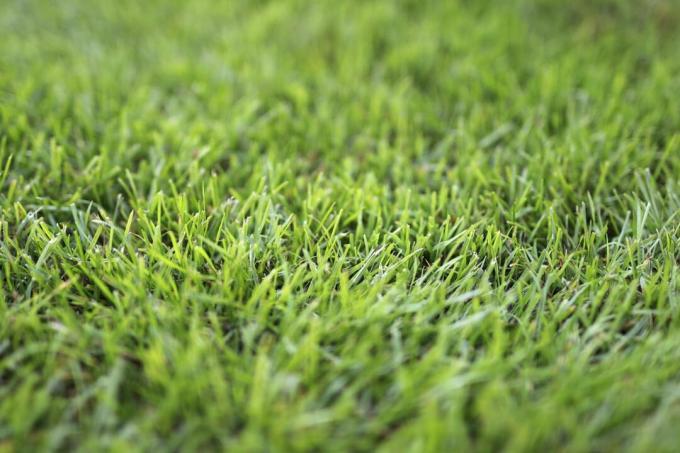
Table of contents
- Homemade nitrogen fertilizer
- In solid form
- From coffee grounds
- kitchen and garden waste
- farm animal excretions
- lawn clippings
- make liquid fertilizer
- Manure from nettles
- Manure from stable manure
Nitrogen ensures healthy growth and the green color of the grass. As a result, they must be supplied with lawn fertilizer at certain intervals. Effective nitrogen fertilizers are relatively easy to make yourself.
Homemade nitrogen fertilizer
A balanced nitrogen balance is essential for the lawn. The right fertilizer ensures an optimal supply of nitrogen. It doesn't even have to be expensive, because many ingredients are used in the household, garden or stable. They can be used to make nitrogen fertilizer or produce nitrogenous fertilizer in solid and liquid form.
In solid form
Here are many easy ways to make an effective nitrogen fertilizer yourself:
From coffee grounds
Coffee grounds are a waste product that can be found in almost every household. In addition to potassium and phosphorus, it also contains a lot of nitrogen, which makes it an excellent natural fertilizer. It decomposes very slowly, so over-fertilization can be ruled out. However, this requires a larger amount, so you have to collect it beforehand. But how does coffee grounds become fertilizer?
- Collect coffee grounds over several days
- then dry well to avoid mold growth
- spread it out well on an absorbent surface
- best in the sun
- leftovers from Store coffee grounds in a dry, airy place
- mow the lawn before fertilizing
- Distribute the dried set evenly over the lawn
- Work it flat into the ground with a rake
Tip:
Adding coffee grounds to compost attracts earthworms and can speed up rotting.

kitchen and garden waste
A good nitrogenous fertilizer can also be made from kitchen and garden waste. We are talking about compost, the classic fertilizer. The main work is done here by soil organisms, which convert the waste into valuable humus. Compost can be created using a quick composter, a wooden shack or simply as a compost heap. It can be built up gradually over the year or all at once. Composting is the fastest with the latter.
- look for a semi-shady place in the garden
- with open bottom, not concreted
- Compost must be well aerated all around
- Rabbit wire on the floor to protect against rodents
- then fill in the material in layers
- bottom layer of tree or hedge clippings
- leaves, grass clippings, small twigs on top
- as the next layer, garden scraps and kitchen waste
- Scatter chopped twigs in between
- as the top layer of grass clippings
So that the compost does not dry out, it must be watered occasionally, but covered in heavy rain. It is ripe after about eight to twelve months. Kitchen waste such as eggshells, coffee grounds, tea bags and leftover fruit, garden waste in the form of leaves, lawn clippings, wood ash (max. 3%) and woody shredded material as well as manure and algae from the garden pond. If you use a commercial quick composter, the filled materials must be chopped or cut into small pieces.
Tip:
A good alternative to regular compost is vermicompost, which has a higher nitrogen content than regular compost. The latter must be implemented regularly every three months to promote ventilation.
farm animal excretions
Manure from various farm animals is one of the most traditional nitrogen fertilizers. The highest concentrations are found in manure from sheep, cattle and pigs. It is just below that for poultry, dairy cattle and horse manure. In order to be able to use the excretions as fertiliser, they must be processed or treated accordingly. to get prepared.
- never spread fresh manure
- contained ammonia would burn grasses
- compost before spreading
- mix with other organic materials for composting
- such as grass clippings, straw, leaves and other garden waste
- cover with a tarpaulin to protect against moisture
- Duration of decomposition varies
- Horse manure rots faster than cattle manure
- requires at least one year
- Manure decomposes during this time
- Disease germs die off
- preferably apply before laying a new lawn
- otherwise spread on the lawn in spring
- Work in lightly with a rake or rake
Unfortunately, these natural nitrogen fertilizers also have one or two disadvantages. They can increase the salinity of the soil and encourage weed growth. In addition, you should only ever compost as much manure as possible. store up for use next year.
Tip:
Incidentally, the duration of the decomposition depends on the animal species, the sex, the age of the animals and the feed.
lawn clippings
The easiest way to supply the lawn with nitrogen is to mulch with grass clippings. However, part of the nitrogen is lost through soil organisms, so that mulch is usually not sufficient as the sole nitrogen fertilizer.
- ideally use a mulching mower
- have special knives
- Lawn should be absolutely dry
- mow the lawn normally
- Blades cut and shred the grass at the same time
- Grass clippings fall to the ground
- Material gradually decomposes
- is then available as fertilizer
- mow about once a week
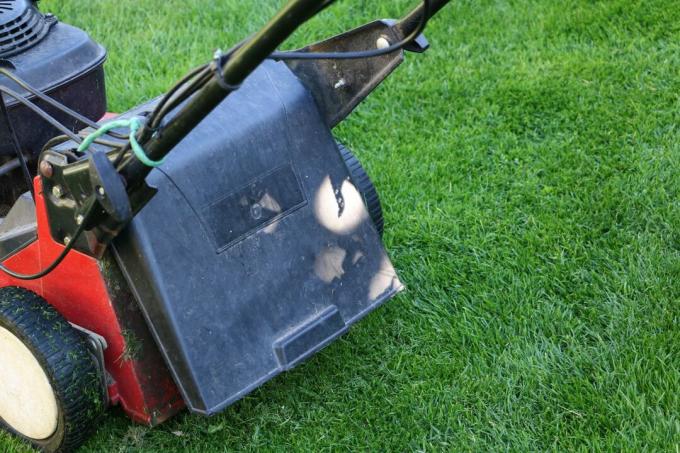
The clippings should not be too wet, too long or unevenly distributed over the area. In places where it is applied too thickly, the grasses cannot be supplied with sufficient light and oxygen. This affects the formation of green leaves, the grasses turn yellow and begin to rot.
make liquid fertilizer
As an alternative to solid nitrogenous fertilizers, liquid fertilizers can also be produced with little effort. Namely in the form of liquid manure, which is then applied with a watering can. Unfortunately, these types of fertilizers are very odorous, but all the more effective. The stench can be mitigated somewhat by sprinkling some rock flour over the brew during fermentation.
Manure from nettles
Nettle lawn fertilizer is high in nitrogen and easy to make. In addition to stinging nettles, you need gloves to protect against the stinging hairs, a plastic bucket or wooden barrel with a cover, scissors and rainwater.
- cut a kilogram of fresh nettles into small pieces
- the smaller the better
- alternatively 150 g dried herb
- Put clippings in the bucket
- then pour 10 liters of rainwater over it
- Mix well and cover container
- then stir once a day
- The fermentation process starts after a day or two
- indicated by rising bubbles, formation of foam
- Fermentation complete when bubbling stops
- after about 10-14 days
- Sieve off fermented plant remains
- Dispose of plant remains in the compost
- or use as a mulch
- Dilute liquid manure 1:20 with water and spread on the lawn
Tip:
Metal containers should not be used to prepare liquid manure, as chemical processes take place between the liquid manure and the metal.
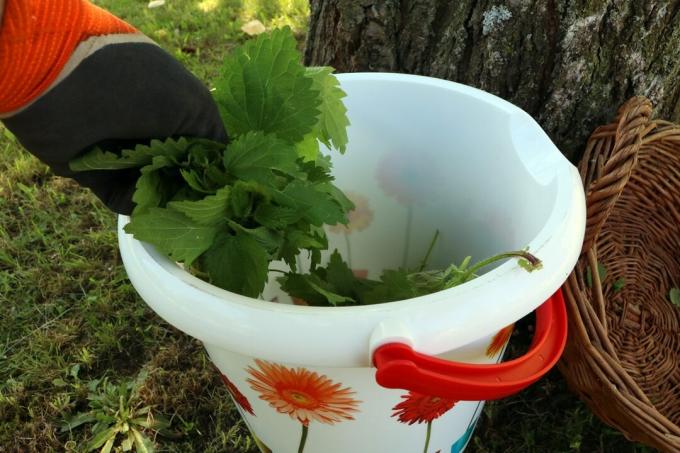
Manure from stable manure
If you eliminate stable manure, you get an effective nitrogen fertilizer. A corresponding liquid manure can be made from different types of manure. However, the manure should already be well rotted.
- mix the rotted manure with wood ash
- three parts manure and two parts wood ash
- only use wood ash from untreated wood
- Put the mixture in a tightly meshed net
- alternatively use an old potato sack
- Soak net or sack in water
- don't use too much water
- the more water, the less has to be diluted later
- put the whole thing in a warm and shady place
- ready liquid manure after a few weeks
- Manure should then be clear and dark brown
A nitrogen-containing lawn fertilizer such as commercially available NPK fertilizer is used. Under no circumstances should it be used pure, but always diluted accordingly. It is best to dilute it with water until the color resembles that of black tea. It can be deployed from March to July.
 garden editorial
garden editorial I write about everything that interests me in my garden.
Learn more about fertilizing
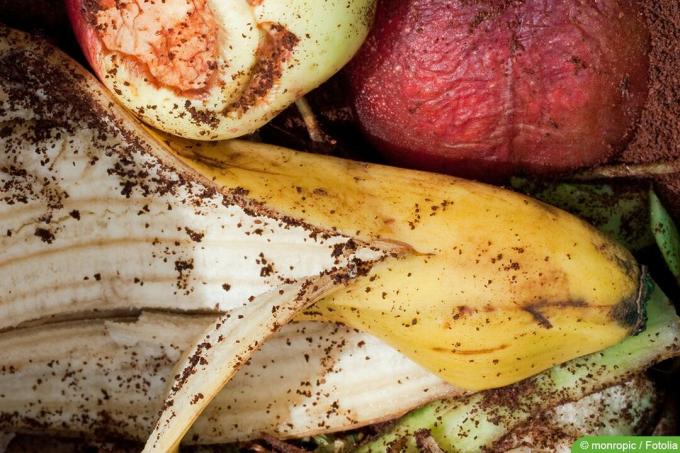
Dried banana peel as fertilizer | Application tips
Bananas are popular and healthy. The banana peel usually ends up in the trash. But it is far too good for that, because the dried shells are an excellent fertilizer for a variety of garden plants.

Horn meal: with fertilizer against clover in the lawn | 7 tips
In the lawn, clover is usually undesirable. With too little fertilization, however, it spreads quickly. Horn meal can help as a biological fertilizer. See this article for tips on how to use it.

Unusual Fertilizers | 13 home remedies that can do more
Much of what accumulates in the household and usually ends up in the organic waste bin can be used to fertilize garden and/or indoor plants. They offer an ecological alternative to mineral fertilizers and score with environmental compatibility and sustainability.
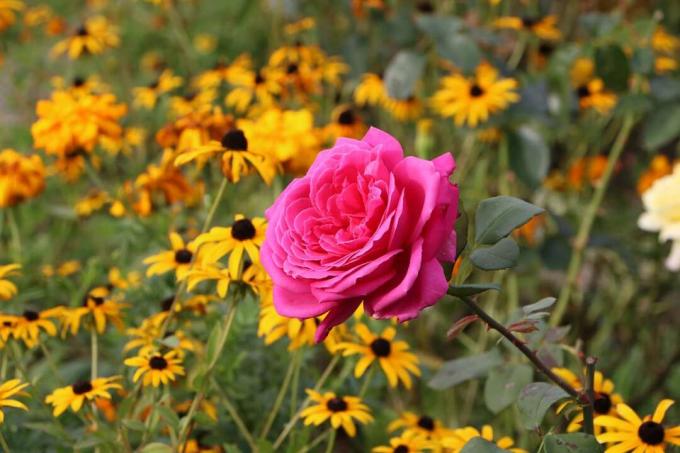
Fertilizer for roses: 15 home remedies for fertilizing roses
In addition to rose fertilizer, numerous home remedies are also suitable as nutrient suppliers for roses. We present the most popular ones in this article!

Fertilize properly | What good is low-nitrogen fertilizer?
No plant can survive without nutrients. Only with optimal and needs-based care can they develop magnificently, bloom lavishly and bring rich harvests. As a result, fertilizer plays an important role in care, provided the ingredients and dosage are right.

ash as fertilizer | These 18 plants tolerate wood ash
Ash is considered a natural fertilizer that supports plants in their development. But not all plants tolerate this form of fertilization. Therefore you should take a look at your garden and/or balcony plants before applying the ash fertilizer.



